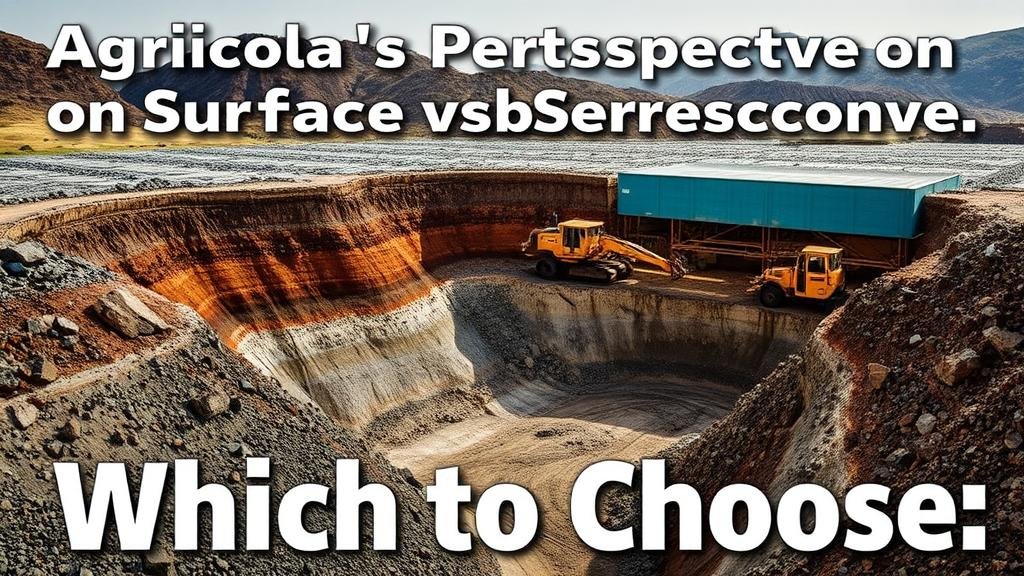Agricola’s Perspective on Surface vs. Subsurface Mining: Which to Choose
Agricola’s Perspective on Surface vs. Subsurface Mining: Which to Choose
Mining has been an integral part of human civilization, providing vital resources for industry, economy, and daily life. As mining techniques evolved, choices between surface and subsurface mining have prompted discussions regarding their advantages and disadvantages. Georgius Agricola, a miner and scholar from the 16th century, is often considered the father of modern mining. His work, De Re Metallica, serves as a foundational text that provides insights into the mining practices of his time, making his perspective relevant in contemporary discussions about mining methods.
The Basics of Mining Methods
Mining techniques can be broadly categorized into two types: surface mining and subsurface mining.
- Surface Mining: This method involves the extraction of minerals or ore from the earths surface. It includes techniques such as open-pit mining, strip mining, and mountaintop removal.
- Subsurface Mining: Also known as underground mining, this technique involves retrieving minerals located beneath the earth’s surface. Methods include shaft mining, room-and-pillar mining, and cut and fill mining.
Surface Mining: Advantages and Challenges
Agricola recognized the efficiency of surface mining, especially for mineral extraction close to the ground surface. This method typically involves lower operational costs and allows for the removal of large volumes of material in a shorter time. For example, open-pit mining is highly effective for mineral deposits such as copper and gold, enabling the movement of large quantities of overburden.
But, surface mining comes with challenges, particularly environmental impacts. Destruction of habitats, soil erosion, and water contamination are significant concerns. Also, surface mining can necessitate extensive land alteration, leading to long-term ecological consequences. A pertinent case study is the coal mining activities in Appalachia, where mountaintop removal has resulted in substantial environmental degradation.
Subsurface Mining: Benefits and Drawbacks
In contrast, subsurface mining generally has a smaller surface footprint, which significantly lessens the environmental impact. Agricola acknowledged the longevity of resources that could be accessed through subsurface methods, allowing for mining activities to continue without disturbing the surface ecosystem for extended periods.
Underground mining applications, like room-and-pillar mining for coal, exemplify this technique’s efficiency and reduced surface impact. The extraction of deep mineral veins–such as gold and diamonds–often makes subsurface mining the method of choice due to the higher ore grades found at depth.
But, subsurface mining can introduce its own set of challenges, such as safety risks to workers and significant infrastructure costs. Accidents in underground mines, such as the Sago Mine disaster in West Virginia in 2006, have highlighted the potential hazards, leading to increased scrutiny and calls for enhanced safety regulations.
Environmental and Economic Considerations
Choosing between surface and subsurface mining often boils down to balancing economic benefits with environmental concerns. Surface mining is generally more cost-effective due to its lower operating costs but may involve higher environmental remediation costs in the long run. On the other hand, while subsurface mining is costlier in terms of initial setup and safety protocols, it may offer sustainable long-term extraction with less immediate environmental impact.
- Statistical Insight: According to the World Bank, the mining sector contributed about 0.6% of global GDP in 2020, emphasizing its economic relevance.
- Environmental Regulation: A study by the U.S. Environmental Protection Agency found that effective land reclamation efforts post-surface mining can restore over 80% of original ecosystems when executed properly.
Conclusion: A Balanced Perspective
Agricolas principles remind us that both mining methods have distinct advantages and disadvantages. choice between surface and subsurface mining should consider not only immediate economic gains but also long-term environmental sustainability and safety concerns. As the mining industry evolves, incorporating advanced technologies such as automated drilling and improved safety measures can enhance the viability of both methods.
Ultimately, the decision for mining stakeholders–whether governments, companies, or communities–should be guided by a comprehensive analysis that weighs economic benefits against ecological and social responsibilities. By prioritizing sustainable mining practices, the industry can continue to serve society while minimizing its environmental footprint.



